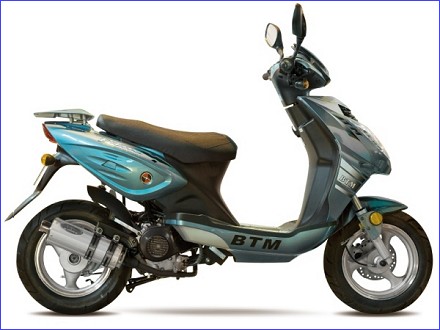
Like our previous urbanised scooter mutation features on Dalek and Dazzle, everything seems to start with a story, and this latest tale is no different… The scene is set at Copdock Motor Cycle Show on 7 October 2018. Even before lunchtime the joint EACC/IceniCAM display had already been awarded ‘Best Club Stand’, and a number of our team had been wandering the jumble field to peruse the various temptations on offer at the usual exorbitant prices.
One such machine was a derelict old BTM-branded Baotian scooter, a truly decrepit case, with the usual busted plastics, missing both mudguards, exhaust, kick-starter, carburetter, air filter, and having no keys or documentation. With obviously little prospect of it even running as a track bike, the piece of cardboard offering this ruin at £35 seemed wildly optimistic for a wrecked Chinese scooter, so everyone just laughed, and walked on…
Towards the end of the show, when everyone was just about starting to pack up, Chris (Moped Doctor) Day went out on a final scout around the jumble field again to see if there might be any last minute bargains to be had, and came back pushing the BTM!
‘Oh, you haven’t bought that rubbish?’ everyone said, ‘No, I got it for nothing’ came the surprising reply!
‘The cardboard sign had been turned round, and written “Free”, so I asked, is that really for free?’
‘Yes, I don’t want to take it home, so you can have it for free if you just take it away’. ‘So here it is!’
To mumblings of ‘You barely got your money’s worth’, still no one appeared impressed, and the momentary novelty quickly seemed to wear off as Chris began to realise that he didn’t even have the means to get it home for breaking up as scrap.
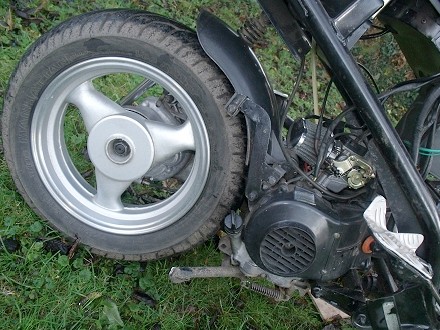
The BTM ended up being cleared from site on the last transport going back to the Mopedland workshops, then sitting out in the yard for weeks, until Chris finally decided he really couldn’t be bothered with it, and ‘donated’ the BTM to Mopedland under the excuse that ‘You’ve always wanted one of these’.
We expressed our enthusiasm at Chris’s generosity by contemptuously leaving the BTM out in the rain till Christmas, when the workshops had pretty much cleared out for the season, and with little more than the prospect of boring festive TV, we dragged the wretched scooter in for assessment.
BTM seems to be an early brand-badged scooter made by Baotian, and built with a 49cc GY6 four-stroke engine. This BTM model was a BT49QT–12C1 Sprint which is based on much the same running gear as all the other models, but just has its own particular body styling. There seems absolutely no reason why the ‘Sprint’ would go any better than any other model, just that the styling might make it look faster.
There was a ‘60’ number plate on the back, which dated the BTM around 2010, and meant the registration documents could be recovered on a V62 (for £25).
Without any keys to unlock the saddle and access the helmet bin beneath, we resorted to removing the rear body panels to disassemble the actuating cable from the lock, then pull the barrel nipple on the end, to pop open the latch and reveal … the decayed remains of a carburetter, half the broken kick-start mechanism from inside the transmission case, and the partial remnants of a variator set.
This might mean the transmission was disabled, so take off the transmission case … to find a new variator and belt had already been fitted! So turn the starter gear—and the engine does turn over with apparent compression; then check the oil-well, maybe black sludge is better than no oil at all.
We then decided that all the bulky broken body panels had to go in order to access and assess everything and, once off, they would certainly never go back on again, so all in the bin and the scooter was stripped down to its bare skeleton.
Deciding to see if the engine would run, the old carburetter was cleaned up and refitted, the barrel extracted from the ignition lock so it could be switched with a screwdriver, then the flat battery filled and charged, but it proved too dead to spin the starter. With no kick-starter, it was off with the engine fan-cover to power the motor over with an electric drill by the magneto nut. With the charger left on the battery, out with the plug, but thwarted by no spark.
Let’s phone someone who knows about these things—‘Chris, this Chinese junk you dumped on us doesn’t spark’. ‘Ah, that’ll probably be the CDI black-box, I’ve got those, so I’ll bring some round and we’ll try swapping a few over’—and soon the set was sparking again! So, hook up a pipe and funnel to fuel the carburetter, power over with the drill, and yes: the motor starts and briefly revs on throttle till the fuel runs out.
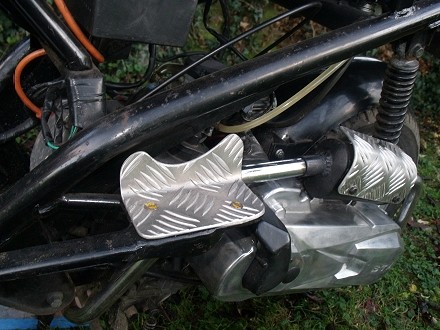
So our BTM might be viable after all!
A left-hand exhaust was planned, so it wouldn’t obstruct removal of the rear wheel on the right-hand side. Nothing seems crazier than the universal standard manufacturing practice of mounting a right-hand exhaust on every scooter that has left-hand single-sided transmission and suspension, which needs the whole exhaust system removed every time you want to take off the rear wheel or access the brake—that’s just daft! So a left-hand exhaust was made up in an afternoon from sections of old ⅞-inch handlebars welded together, and using an old lawnmower silencer box mounted above the transmission case so the cover could still be removed with the exhaust in place. So obvious, and so simple! It sounds perfectly acceptable for an MoT test, and looks surprisingly tidy, so why can’t all the scooter manufacturers do that?
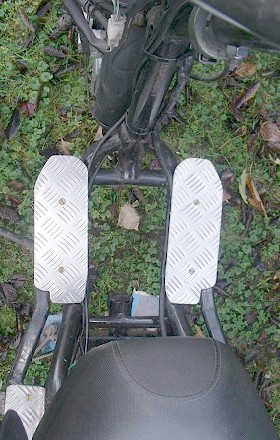
Since the exhaust now takes the place of the original air box (which we didn’t have anyway), we’re fitting a cheap aftermarket through-flow air filter straight on the back of the carburetter anyway, so that’s all fine.
The Baotian kick-starts have a bad reputation for failure if used, so we decide not to bother replacing ours. Instead we opt to fit a larger battery for reliable on-the-button starting, and figure that by trimming a few plastic webs out of the battery box we can tuck in a 12V × 8.4Ah, in place of the feeble 12V × 4.2Ah standard economy battery that always seems to struggle to turn these motors over. The battery box was originally located in the footplate and hanging between the frame rails, but James (our pacer) suggested ‘Why don’t you put it beneath the seat?’ Hmmm, we rather liked the idea of that, because taking the battery from between the lower frame rails meant you would be able to see the road beneath you when you looked down, which could be a little unusual, and we could simply mount two footplates onto the frame rails.
We also wanted to maintain a see-through aspect to the skeletal frame look, with easy and practical access to the carburetter, so decided to cut the whole bulky bottom out of the helmet bin, and return rigidity to the top of the bin by riveting a 2mm metal plate to the remaining shallow dish beneath the seat.
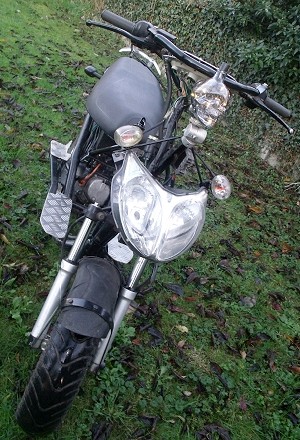
A forward seat-mounting frame was fabricated from more scrap handlebar tubes, and the battery box re-hung inside the front of the plate beneath the seat. By cutting more holes inside the front and back of the plate, we could also squeeze all the local black boxes, CDI, HT coil, and associated wiring tidily in beneath the saddle.
Since we were re-using the original dual-seat, we fabricated and welded on rear footrest mounts in the same positions that the original plastic panels had located them, and then we trimmed them off with our hallmark aluminium chequer plate back footrests to match the front footplates.
The original headlight unit, which fitted into the plastic front panel, was remounted on a simple metal frame in much the same position, and the speedo/instrument assembly clamped between two form-cut chequer plates to bolt onto two original handlebar lugs.
The whole impression was beginning to look like one of Gunter Von Hagens’s bizarre plasticized anatomical exhibits, and our skeletal scooter had already popularly adopted the title of the He-Man cartoon’s evil nemesis: ‘Skeletor’.
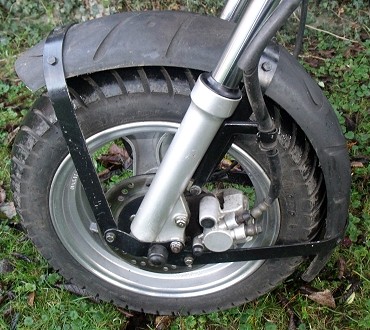
Martin Gates suggested making a front mudguard from a tyre, and we liked the thought of that too, particularly since we needed to replace the worn out and damaged rear tyre anyway, so we sliced the old tyre up with a disc cutter, then bolted it to fabricated stays made from metal strip. It’s an interesting double-take feature, and we wonder if we might ever get prosecuted for having insufficient depth of tread on our front mudguard?
With all the electrics now working, and most primary components in place, Skeletor was now capable of its initial test run, but this didn’t go well because throttle response was particularly poor due to very weak main jetting, and probably also due to not having the original air box. We couldn’t even get up enough revs to get the CVT to change up ratio—just 15mph, useless!
The original carburetter (in very decrepit condition) which came with the bike, had an 81 main jet, and the workshops found there were new complete carburettors available on-line for less than £20, so it barely seemed worth the effort of spending further time on the old carburetter. At that price, many motor cycle agents wouldn’t even bother cleaning one, just fit a new carburetter!
The new carburetter came fitted with an 85 main jet, but since we’d fitted a high-flow aftermarket filter, a 95 seemed to suit it better. With an increase in jet size, there may be some performance improvement, and probably a fuel consumption increase too.
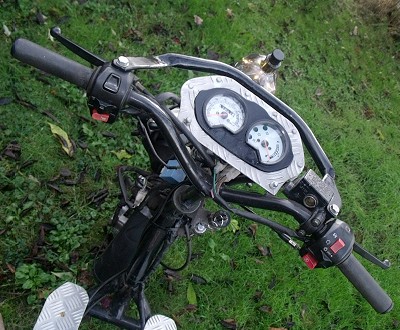
While the technical issues had caused Skeletor to miss its planned debut at the Peninsularis Run on 14 July, there was confidence that the problems would soon be resolved, so V5c registration documents and insurance had already been secured. Once the new carburetter and re-jetting achieved a more capable performance, we whizzed it through MoT & tax, for its first shakedown run at the EACC Periwinkle Run on 11 August.
While Skeletor completed the course with a reliable and capable performance, it proved quite unpleasant to ride due to constant over-revving and vibration, since the driving ratio always seemed too low, right through its variator range.
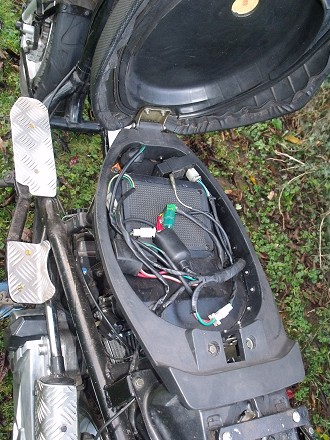
Back at the workshops, the transmission was stripped out to examine and weigh the six CVT variator rollers, at an average of just 5.5g each. This seemed unusually light, and the aluminium cores even appeared to have been crudely drilled out to make them even lighter than when they originally started. Since the variator rollers were new and apparently unused, we can only conclude that someone didn’t get far with their home tune-up!
Wanting to drop the revs throughout the CVT range, we opted for a 9g brass-core roller set (rollers in all sizes and weights are readily and cheaply available, so the reaction point can be easily tuned to whatever you may prefer). The 21g weight increase delivered a marked improvement to reduce revs and vibration, so a good result first time from a calculated guess.
Changing the roller weights doesn’t alter the achievable top speed, just the revs that the engine runs at until the variator gets to the top of its range, and reducing the roller weights to increase low-range revs on a 50cc four-stroke GY6 is most likely to only increase the fuel consumption, with a negligible effect to the acceleration.
A follow-up trial at the Bluebell Run on 18 August found Skeletor a whole lot nicer to ride, but revealed further problems in the wet conditions as the indicators switch stuck on left or right, but wouldn’t cancel, and the rear tyre threw water and mud past the short end of the close fitting ‘rear hugger’, and all over the carburetter and electrics—which caused some ‘running issues’. We still completed the course again, though maybe further development was required…
Following further dry-run outings at the Coprolite Run on 8 September and Norfolk Broads Run on 22 September, a forward camera mount and speedo instrument bar to enable a clip-on-mounting for a course route finder were added to the handlebar set before Skeletor’s display on the joint EACC/IceniCAM stand at Copdock Show on 6 October 2019.
During early November with the evenings drawing in, we experienced our first ride in the dark, and with twin 12V × 35/35W headlamp bulbs, you’d think the illumination would be fantastic—but no, it’s completely ineffective on both beam and dip. The plastic lens on the lamp just seems to scatter its light everywhere except where you really want it, in front of you! Joseph Lucas in his role as ‘The Prince of Darkness’ at the seasonal pantomime would have been proud that the banner of his legacy is still being carried today.
Skeletor got another club outing at the Kneels Wheels Run on 24 November but at just three miles out, suffered a throttle cable seizure and stuck at full throttle … with the daunting prospect of some 25 miles still to go, along wet and muddy roads. The course was completed under some duress, by a combination of holding the bike back on brakes, and flicking the motor in and out by use of the handlebar kill switch, which made corners and junctions particularly difficult. The whole back of the bike was again liberally splattered with water and mud, which also reminded us again of the need to deal with the ‘dry weather rear mudguard’ problem.
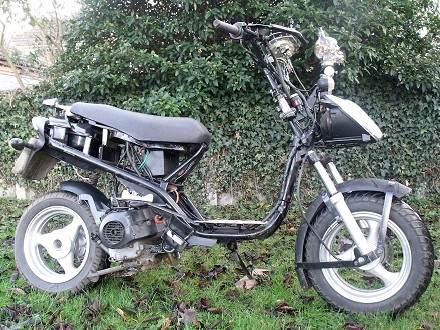
In the spirit of the bike’s name, Halloween presented the opportunity to acquire very cheaply (pound shop), an LED illuminated smoked glass skull, which can be fitted to the forward camera mount by a threaded plate bonded to the base of the crystal skull, then fixed in position by the camera lock-ring … all in the best possible taste of course.
The Skeletor urbanised scooter will probably be an on-going development for a while, but how does it actually go today? Let’s have a look…
The tubular frame seems stout and study, though it lacks the elegance of style and finish since it is ordinarily disguised under plastic body panels.
The steel fuel tank fitted on early models (later models have plastic tanks) is tidily located behind the saddle, and is topped with a standard fitment of a cast aluminium ‘aerofoil’ on the BT49QT–12C1 Sprint models, which had the fake carbon-fibre finish burnt off with oxy-acetylene, then polished and retained for use as a practical handling hold.
The sturdy telescopic front forks have stout aluminium sliding legs, and mount nice and chunky cast alloy 12-inch wheels fitted with a wide 120/70–12 tyre on the front, and 130/70–12 tyre on the rear, which look a whole lot beefier than the more usual 10-inch wheels on most other commuter scooters.
There’s a firm centre stand, and a jaunty side stand, which immobilises the ignition if it’s left down.
Trying the frame for size, it seems to stand somewhat taller than Dalek or Dazzle, while the rear suspension feels firm, though poorly damped at the rear.
The handlebar position feels quite high for a 50cc scooter, and the instrument panels house the speedometer; an intermittently indicating fuel gauge; and warning lights for indicators left, right, & headlamp beam; but nothing to tell you whether the ignition is actually off or on?
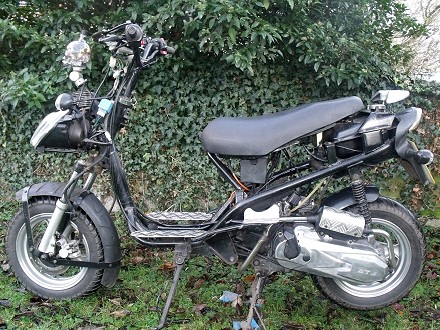
The ignition switch is halfway down the right-hand side of the headstock stem and would probably have had a steering lock feature originally—but no longer has a lock, just a metal blade with a brazed shoulder washer with a key ring in its eye. It sort of looks like a key, but just turns the barrel, and stops water getting into the works.
The starter motor is ‘brake-enable’, so you have to pull in either front or rear brake levers for the engine to spin, but do note the immobiliser switch on the right-hand bar, because ‘clever-dicks’ like switching these to the off position so your bike won’t start, and they think that’s funny.
The right-hand bar also has lights on, side, and main, with beam/dip on the left-hand bar. Start button at bottom right, horn button at bottom left, and indicators on the left bar, left/right, and push to cancel.
There seems to be a bit of twisty throttle required to effect the accelerator pump and initiate starting, but with a little persistence the motor does fire up with a primitive four-stroke thumping from the exhaust as the motor runs rich in its automatic choke phase. Trying for an immediate getaway doesn’t seem to work as the engine dies out as the throttle is wound back, so it needs to be eased into motion through the cold phase on just light throttle.
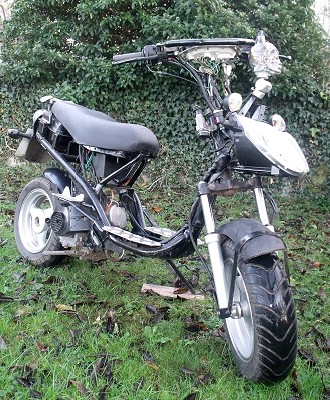
Look down to get the positions of the separate footplates into your mind so you know where to put your feet, and it is rather odd to clearly see through to the ground moving directly beneath you—we can’t readily think of any other machines quite like that. Some may find the prospect a little disconcerting…
Cruise round the corner, then feed in the throttle up the road, and it seems the motor has already warmed enough to respond. The exhaust tone rises to a growl as the revs increase, and then just sits at the same revs as the bike steadily accelerates.
The ‘soft tune’ motor has a very ‘even’ power delivery, and the CVT is totally reactive, so holds constant revs throughout its operating spectrum, and the revs only start to increase further once the variator gets to top of its range.
While the theory says this should give best and most economical performance with the motor constantly and automatically operating at optimum torque, it does make the bike rather boring to ride. You soon start to miss the fluctuating revs and exhaust tone changes you naturally get from a geared motor cycle. Skeletor sounds a bit like an old-school motor cycle, but it’s only pretending—it’s still just an automatic scooter with a four-stroke engine. It’s also a low-power four-stroke engine, and fails to deliver anywhere near the same acceleration of its two-stroke cousins.
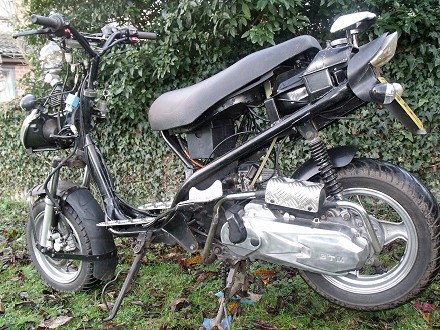
Open the throttle on Dalek, and the power comes in with a punch. Dazzle delivers a strong take-off too, but Skeletor gets left behind and just steadily builds up its pace.
When you have managed to get speed up beyond the top end of the CVT range, which seems to happen somewhere between an indicated 30–35mph, and the revs rising above optimum torque point, finally things can start to become a little more interesting. You have to ‘work’ to get the speed up, by hanging onto the throttle, and crouch down a little to reduce the drag, but you should be rewarded as the pace can steadily keep building.
The speedometer is dual-indicated in mph up to 80, and mph up to 50, but we’re not quite sure how that can work with the odometer reading? You soon get the impression that the speedo is optimistic, so how does it really go?
Indicated 30 = Sat-nav paced 26, indicated 40 = Sat-nav paced 36, and our best light downhill run on our blustery test day indicated 49, which our pacer clocked at 43mph.
The best speed so far on other occasions has indicated just past the end of the dial, at 51 downhill, and again 51 along the flat with a good tailwind, so it might be just about possible to work up to 45 under favourable conditions.
The bike seems to ride ‘tall’, and the centre of gravity feels too high—it’s as if you’re perched on top of the frame rather than feeling part of the machine. The headstock geometry and wide tyres make the steering feel heavy, general handling is cumbersome, and low speed handling is particularly clumsy. The low power motor with its seemingly tall gearing will probably prevent the engine from ever revving out, and it will labour hard against a head wind. Both brakes seem to require a higher level of lever force in proportion to their effect, and considering the twin bulb headlamp is outputting 70W on main beam and dip, it’s unbelievable useless!
The four-stroke motor may not deliver the performance of its two-stroke counterparts, but that exhaust makes it sound so much better. Shut down the throttle from revs, and you do get a bit of that classic four-stroke overrun growl, sometimes accompanied by small incidental gurgling backfires as air is drawn into the silencer box through unsealed exhaust joints.
You get those occasional moments where Skeletor sounds a bit like a real old motor cycle, and it can be good.
Development is still on-going…


